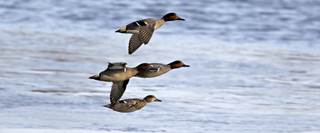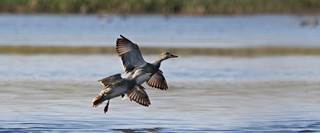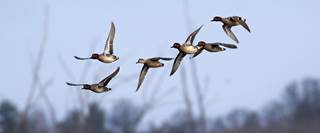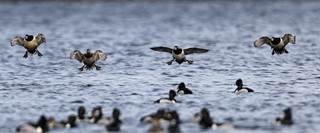Five Atlantic Flyway Public Land Hotspots for 2020
Find ducks and geese on public land in the Atlantic Flyway
Find ducks and geese on public land in the Atlantic Flyway

The Atlantic Flyway stretches from the frozen north to the tropical south, encompassing a wide variety of habitats along the way. The species that call this flyway home are equally diverse, from tiny teal to giant Canada geese. But perhaps the best part is the abundance of public land available to waterfowlers and other outdoor enthusiasts throughout the flyway.

The Saint Lawrence River flows northeast from the top of Lake Ontario to the north Atlantic via the Gulf of Saint Lawrence, the worlds largest estuary. In addition to being a vital shipping route, the big river is an important travel corridor for migrating waterfowl. Nesting populations of ducks and geese reside on both the Canadian and US sides of the river, producing large numbers of local birds each year.
You want to be here for opening day, says wetland specialist Mathew Shawl. Shawl has hunted the region since he was a boy, chasing ducks and geese on public lands. The early season offers plenty of mixed-bag action, with wood ducks, mallards, and teal making up the majority of the bag, although gadwalls and wigeon usually make an appearance as well.
When the season opens, you can find wood ducks on just about any wetland and shallow impoundment, Shawl says. We usually see good numbers of mallards too.
The river itself also offers fantastic gunning, first for dabblers then for hardy divers such as goldeneyes and redheads later in the season. The mosaic of backwaters in the Thousand Islands region holds good numbers of mallards, black ducks, and green-winged teal when New Yorks season opens in early October. Those with seaworthy boats can pursue late-season divers in the larger sections of the river, where ducks will concentrate when smaller bodies of water begin to freeze around Thanksgiving.
Public land hunters without boats should consider Wilson Hill and Upper and Lower Lakes Wildlife Management Areas (WMAs). Wilson Hills 4,000 acres host as many as 20 different species of waterfowl during peak migration. Located adjacent to the Saint Lawrence River in Massena, Wilson Hills open-water wetlands provide habitat for an assortment of dabblers, divers, and geese. Farther south, Upper and Lower Lakes WMA comprises nearly 9,000 acres of wetlands between the Grass and Oswegatchie Rivers.
When its hot: October for dabblers, November for divers
Abundant species: Mallards, wood ducks, black ducks, green-winged teal, ring-necked ducks, common goldeneyes, buffleheads, Canada geese
For detailed information, visit dec.ny.gov/.

While best known as a venue for pro football, New Jerseys Meadowlands also host good numbers of migrating and wintering ducks. Located just west of Manhattan, the Meadowlands consist of approximately 8,400 acres of salt marsh and adjacent lowlands located within view of the New York City skyline. Despite being bisected by roadways, the marsh is home to good numbers of black ducks, mallards, and green-winged teal.
The Meadowlands were so named because early Dutch settlers drained some of the marsh flooded by the Hackensack and Passaic Rivers as they flowed into Newark Bay to create meadows for planting crops. Farming gave way to industry, and much of the wetland complex became industrialized in the 1960s. Despite all the development, waterfowl continued utilizing their historical wintering grounds. Now, these wetlands are one of the few places where you can raise a shotgun on a decoying black duck with the Empire State Building or Giants Stadium in the background.
Everything in the book except goldeneyes and wood ducks show up here, says veteran duck hunter, decoy carver, and president of New Jersey Waterfowlers Gary Bell.
The 741 acres of Saw Mill Creek WMA, managed jointly by the New Jersey Department of Environmental Protection and the New Jersey Sports and Exposition Authority, can be accessed only by boat. There, hunters can set up against the salt grass for dabbling ducks concentrated by the falling tide. During periods of high water, setting up on points can offer opportunities to bag buffleheads and other diving ducks.
Youll need to take some precautions when you hunt tidal marshes, however, and the Meadowlands are no exception. Keep the tides in mind so your boat isnt high and dry when you need to leave. Additionally, tides can join forces with the wind to create rough conditions and strong currents, so be sure your boat is up to the task.
When its hot: December and January
Abundant species: Black ducks, mallards, northern shovelers, pintails, gadwalls, green-winged teal, buffleheads, hooded mergansers, Canada geese
For more details about this destination, visit nj.gov/dep/fgw/

The Santee River winds through South Carolinas coastal plains for 143 miles before meeting the Atlantic Ocean at the largest river delta on the east coast. Like other river deltas, the Santee offers incredibly productive habitat, with rich soils supporting an abundance of wetland vegetation and invertebrates for waterfowl and other wildlife.
While much of the land surrounding the Santee River is private, there is plenty of space available for public land hunters in the delta itself. The South Carolina Department of Natural Resources (DNR) maintains a series of wildlife management areas along the river, including Santee Coastal Reserve and Santee Delta WMA. The quality of the hunting makes participating in the draw system worthwhile.
Santee Coastal Reserve WMA is known as a top producer for public land hunters in the Palmetto State. This 24,000-acre property includes former rice fields that are managed for the benefit of waterfowl. These parcels, which include Murphy Island, Cedar Island, and the Cape, include blinds that are hunted on a limited basis to keep pressure low and success high.
The hunts are strenuous, because marsh hunts are never easy, notes Alicia Farrell, regional coordinator with the South Carolina DNR, citing the seemingly bottomless nature of the pluff mud in the wetlands. But hunters who can handle the difficult walk will be rewarded with an exciting mixed-bag hunt.
Green-winged teal and gadwalls make up the majority of the bag on the Santee, with mallards, blue-winged teal, wigeon, and pintails also available in smaller numbers. Mottled ducks also occasionally make an appearance, and you can expect scaup and ring-necked ducks to show up at some point during the season.
Santee Delta WMA offers open-marsh habitat like the Coastal Reserve, but also features some picturesque stands of flooded timber. The timber hole is your best shot at a greenhead, although hunters take plenty of wood ducks there as well. Green-winged teal are the most prevalent ducks on the WMA, but shovelers also appear in good numbers. Gadwalls, ring-necked ducks, wigeon, and pintails occasionally drop in as well.
When its hot: December and January
Abundant species: Green-winged teal, blue-winged teal, gadwalls, mallards, northern shovelers, wood ducks, pintails, ring-necked ducks
For more detailed information, visit dnr.sc.gov/.

Georgia isnt known as a hotbed of waterfowl activity, but hunters in the Peach State still bag their fair share of ducks. While the hunting can be hit-and-miss, there are a few spots that produce consistently for hunters willing to put in some work. One such location is the southern end of the Altamaha River, which is home to several wildlife management areas. The bulk of the action is for wood ducks, but other species find their way into hunters bags as well.
Altamaha WMA is one of Georgias premier waterfowl areas, with 3,235 acres of wetlands holding plenty of migrating and wintering ducks. Portions of the wetlands are managed to produce smartweed, panic grasses, sedges, wild millet, and agricultural crops to attract ducks. Water levels are also managed, with drawdowns occurring periodically to benefit waterfowl and shorebirds.
The first half of the season is best in terms of duck numbers, says David Mixon, regional supervisor for the Georgia DNR. But in colder years, he says you shouldnt discount the second split as the snow and ice line pushes down a wide variety of ducks. In really cold years, weve even seen redheads, he adds.
Altamaha WMA consists of three units, Butler Island, Champney Island, and Rhetts Island, with each having its own regulations. Hunting is permitted only on certain days, so be sure to check with the Georgia DNR before making any plans.
Butler Island offers a turnkey hunting experience. Hunters are dropped off in the vicinity of their assigned blinds. Space for each hunter is allotted via a draw, with a standby draw occurring if hunters selected in advance fail to appear on the morning of their hunt.
If youre a walk-in hunter and dont get drawn for Butler, head over to Champney Island. Keep in mind that the farther you walk, the more likely you are to avoid the crowds and find ducks. Rhetts Island is accessible only by boat, and youll have to navigate the dike system to get around. Just be sure to arrive early, as this area is very popular.
When its hot: Late November and December
Abundant species: Wood ducks, green-winged teal, blue-winged teal, mottled ducks, ring-necked ducks
For more detailed information, visit georgiawildlife.com/altamaha-wma.

The Everglades are a unique ecological wonder, composed of a sprawling wetland complex that spans from just outside Orlando all the way to the southern tip of Florida. These extensive, interconnected wetlands are so important to water birds that the Ramsar Convention designated the Everglades a Wetland Area of Global Importance. Fortunately for freelance waterfowl hunters, most of it is accessible to the public.
The staples here are mottled ducks, teal, and ringnecks, says Florida native and waterfowl photographer Eric Orlando. Other ducks found in the Everglades include wood ducks, shovelers, wigeon, and scaup. Hunters also have the opportunity to harvest some rare species, such as black-bellied and fulvous whistling ducks. Because the Everglades are so vast, it pays to scout because ducks can be nearly anywhere. Hydrilla is a duck magnet, so keep your eyes open for it.
The time around Thanksgiving can be good if its been cold enough to push the ringnecks down. But middle to late January is best, says Orlando, noting that the birds are in prime plumage by that time of year.
When its hot: December and January
Abundant species: Blue- and green-winged teal, wood ducks, ring-necked ducks, scaup, northern shovelers, pintails, mottled ducks, black-bellied whistling ducks, fulvous whistling ducks.
Public access can be found on state and federal land. For detailed information on how to hunt the Everglades, visit myfwc.com/recreation/notices/
Ducks Unlimited uses cookies to enhance your browsing experience, optimize site functionality, analyze traffic, and deliver personalized advertising through third parties. By continuing to use this site, you agree to our use of cookies. View Privacy Policy